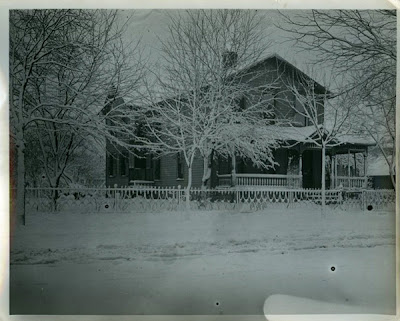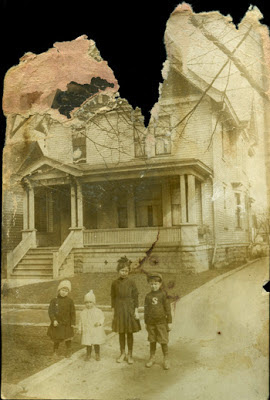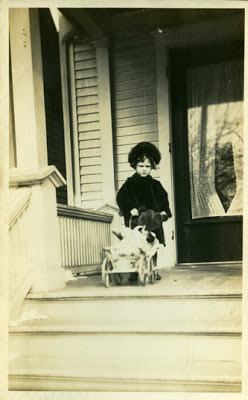A recent donation of materials to the Sandusky Library Archives Research Center helps to bring family histories to life. Two houses on Perry Street tell the story of the Schnaitter and Smith families, whose lives played out on their front porches during the early 1900s. Although most of the photographs from the Howard collection were unlabeled, we became history detectives to discover more about the pictured families.
Merchant tailor Frank Schnaitter married Christina. Their five children were Antoinette (Nettie), Frank (1880-1913), Edward (
see previousblog entry), Gertrude, and Florence. The children were raised in a beautiful Victorian house at 812 Perry Street.
![]() |
| The Schnaitter home prior to 1920 |
Bicycles were popular at the turn of the century when Nettie Schnaitter, at around age 20, began spending time with Freeland Smith. She enjoyed riding with Freeland and his sister, Lottie.
![]() |
| Freeland Smith and Nettie Schnaitter. The two boys could be her brothers Edward and Frank. March 28, 1897. |
![]() |
| Left to right: An unidentified woman, Lottie, and Nettie pose with their bicycles in front of Nettie’s house. The two boys talking on the porch could be Nettie’s brothers Edward and Frank. March 31, 1897. |
Freeland Smith worked as a bookkeeper at Donahue Hardware at 735 Water Street, and he and Nettie Schnaitter were married around 1903. Nettie soon gave birth to Elizabeth “Betty” Smith, James “Bud” Smith, and Frank “Pink” Smith.
------------------------------
In 1910, a house was built at 808 Perry Street, beside Nettie’s childhood home where her parents and siblings were still living. Soon after, Freeland opened Smith Hardware, which he and Adam Smith later managed. The Smiths lived with the Schnaitter family for several years, and Nettie’s daughters, Margaret “Polly” Smith and Patricia Gertrude Smith, were born in 1911 and 1917, respectively.
By 1915, Freeland and Nettie’s family had moved into the house at 808 Perry Street . That same year, the address numbering system changed, so 812 became 810, and 808 became 806 Perry Street.
Nettie’s children spent happy times playing on the front porches of both houses.
![]() |
| Children, likely Elizabeth, James, Frank, and Margaret Smith stand near the Perry Street homes. |
![]() |
| Elizabeth and James Smith, Seymore Bloker, Roy Seebeck, and Frank and Margaret Smith pose on the porch of 808 Perry Street. |
![]() |
| Margaret Smith plays with a doll and buggy on her front porch of 808 Perry Street. February 15, 1914. |
Even though Nettie was about 7 and 19 years older than her younger sisters, they seemed to be close. Many photographs show Nettie’s children spending time with their next-door neighbors, Aunts Gertrude and Florence Schnaitter.
![]() |
| Left to right: Gertrude and Florence Schnaitter stand beside Nettie Smith. Frank and Margaret Smith, holding a doll, stand in front. All are bundled in winter clothes. The photo is probably dated around 1915. |
![]() |
| Likely Elizabeth and Margaret Smith standing with their Aunt Gertrude Schnaitter.
|
Around 1920, the front half of the house at 810 Perry was moved to 5th Street.
![]() |
| House at 810 Perry Street after the front was moved. |
Gertrude married A. R. Warner and moved to Deerfield, IL, while Florence married Claude Miller. Then the elder Frank Schnaitter died in an ice boating accident in 1928. By 1930, Florence and Claude were living alone at the 810 Perry Street house.
In 1939, Freeland was working as the vice president of Smith Hardware. By 1940, Florence and Claude had moved to Cleveland, and Claude’s brother, Edmund Miller, was renting the 810 Perry Street house for his family. The next year, Freeland, Nettie, and their three youngest children, now adults, had moved back into the old Schnaitter home at 810 Perry Street.
Freeland passed away in 1949 and is buried in Oakland Cemetery. Nettie lived in the 810 Perry Street house until her death in 1967.
Elizabeth married Harold Stockdale, and their family settled in Sandusky. She died before her mother, in 1959.James Smith married, settled his family in Sandusky, and worked as chief engineer at Union Chain. He passed away in 1984.
Frank Smith went on to study art. He supervised art instruction in the Sandusky school system and founded the Sandusky Cultural Center. He died in 1999. Margaret Smith worked as a dental hygienist, spent several winters helping Florence and Claude with the charter dishing business, and was active in several local organizations. Patricia Smith married Dean Howard and settled in Peoria, Illinois. Both Margaret and Patricia passed away in 2009.
Today, both homes on Perry Street are still standing.
![]() |
| The 806 Perry Street house today. |
![]() |
| The 810 Perry Street house today. |






























































